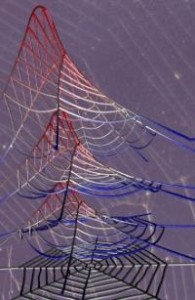I’ve written about spiderwebs before (mostly recently in my Dec. 9, 2011 posting titled, Music, math, and spiderwebs. Researcher, Markus J. Buehler, was featured in the Dec. 2011 posting and he is featured in this one too. I imagine he’s the ‘go to’ spiderweb researcher at MIT (Massachusetts Institute of Technology).
The most discussed characteristic of spiderwebs is their strength, a topic of endless fascination. The Feb. 1, 2012 news item on physorg.com offers a new take on this phenomenon,
While researchers have long known of the incredible strength of spider silk, the robust nature of the tiny filaments cannot alone explain how webs survive multiple tears and winds that exceed hurricane strength.
Now, a study that combines experimental observations of spider webs with complex computer simulations has shown that web durability depends not only on silk strength, but on how the overall web design compensates for damage and the response of individual strands to continuously varying stresses.
Reporting in the cover story of the Feb. 2, 2012, issue of Nature, researchers from the Massachusetts Institute of Technology (MIT) [team leader Markus Buehler, associate professor of civil and environmental engineering at MIT] and the Politecnico di Torino [team leader Nicola Pugno, Professor of Solid and Structural Mechanics at the Politecnico di Torino] in Italy show how spider web-design localizes strain and damage, preserving the web as a whole.
Very simply, two of the types of spider silk that give the webs their strength were examined separately and together. From the news item,
Viscid silk is stretchy, wet and sticky, and it is the silk that winds out in increasing spirals from the web center. Its primary function is to capture prey. Dragline silk is stiff and dry, and it serves as the threads that radiate out from a web’s center, providing structural support. Dragline silk is crucial to the mechanical behavior of the web.
If you’re a weaver, that description will like remind you of warp and weft. The warp threads provide the strength and remain immobile while the the weft threads are the ones you weave in and out and use to create patterns, etc. if you are so inclined.
These observations about viscid and dragline silk have practical applications (from the news item),
“The concept of selective, localized failure for spider webs is interesting since it is a distinct departure from the structural principles that seem to be in play for many biological materials and components,” adds Dennis Carter, the NSF program director for biomechanics and mechanobiology who helped support the study. [emphasis mine]
“For example, the distributed material components in bone spread stress broadly, adding strength. There is no ‘wasted’ material, minimizing the weight of the structure. While all of the bone is being used to resist force, bone everywhere along the structure tends to be damaged prior to failure.”
In contrast, a spider’s web is organized to sacrifice local areas so that failure will not prevent the remaining web from functioning, even if in a diminished capacity, says Carter. “This is a clever strategy when the alternative is having to make an entire, new web!,” he adds. “As Buehler suggests, engineers can learn from nature and adapt the design strategies that are most appropriate for specific applications.”
According to David Kaplan’s Feb. 2, 2012 article for MIT News, the spiderweb’s localized failure was a considered a sign of weakness,
It turns out that a key property of spider silk that helps make webs robust is something previously considered a weakness: the way it can stretch and soften at first when pulled, and then stiffen again as the force of the pulling increases.
This stiffening response is crucial to the way spider silk resists damage. Buehler and his team analyzed how materials with different properties, arranged in the same web pattern, respond to localized stresses. They found that materials with other responses — those that either behave as a simple linear spring as they’re pulled, or start out stretchy and then become more “plastic” — perform much less effectively.
Spider webs, it turns out, can take quite a beating without failing. Damage tends to be localized, affecting just a few threads — the place where a bug got caught in the web and flailed around, for example. This localized damage can simply be repaired, rather than replaced, or even left alone if the web continues to function as before. “Even if it has a lot of defects, the web actually still functions mechanically virtually the same way,” Buehler says. “It’s a very flaw-tolerant system.”
Here’s an image that illustrates how spiderwebs react to stress,

Images show the successive deformation states as loading is increased on a spider web, with red marking high stresses. Simulation picture by S. Cranford & M.J. Buehler/MIT, photographic image by Francesco Tomasinelli & Emanuele Biggi.
The researchers’ article in Nature, Nonlinear material behaviour of spider silk yields robust webs by Steven W. Cranford, Anna Tarakanova, Nicola M. Pugno & Markus J. Buehler is available behind a paywall.
Note: I’m pretty sure I searched to find out if it should be spiderwebs or spider webs. I will investigate further but do not have time now. Meanwhile, I committed to spiderwebs in Dec. 2011.
Pingback: Producing stronger silk musically « FrogHeart